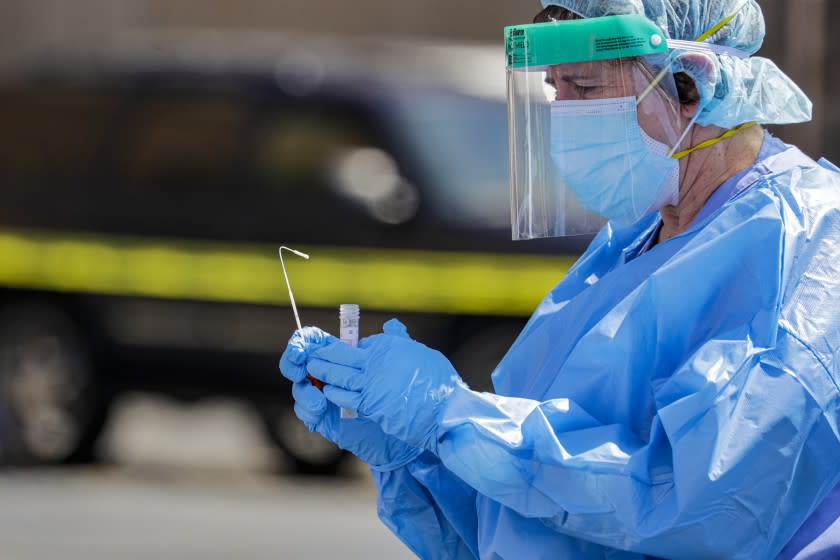Coronavirus testing hits snags in Inland Empire

Riverside and San Bernardino counties are feeling the impacts of nationwide coronavirus testing problems, officials said this week.
After a spike in the number of reported infections last week in Riverside County that went as high as 1,400 cases daily, the number dipped Tuesday to 733. Brooke Federico, the county’s public information officer, said the decline is related to a backup in test results from commercial testing labs LabCorp and Quest Diagnostics.
“LabCorp has put out several public statements explaining that they have been experiencing delays in processing all of the samples due to the volume that’s coming through,” Federico said. The county’s “reduction in cases is not indicative of the disease slowing, but rather this lag time in getting results back.”
Riverside County currently has the ability to test 4,000 people daily, about 800 more than could be tested in May, Federico said. The county has tested nearly 300,000 people, records show.
Dr. Cameron Kaiser, the county's public health officer, said that despite the lower case count this week, “we’re far from being out of the woods.”
“Summer heat isn’t stopping COVID-19," he said. "We need to reduce the impact on our hospitals by reducing transmission, and as long as the numbers keep rising, the state’s need to reimpose restrictions will keep rising too.”
Riverside County hospitals reached 99% capacity in their intensive care units at their peak in late June. Capacity has remained high — 90% or greater — through mid-July, Federico said.
On Wednesday, 536 people were hospitalized, with 136 in ICUs, officials said. Federico said the county can accommodate up to a 35% surge at each hospital if necessary.
In San Bernardino County, a lack of supplies is also hampering testing efforts. Last week, the county had to cancel 11,000 appointments at various sites amid the shortage, county spokesman David Wert said Wednesday.
Tests are still "severely limited and haven't improved," so facilities will be taking only a limited number of appointments each day, Wert said. With the reduced capacity, about 2,200 tests can be conducted daily.
The county is securing agreements with a handful of additional testing vendors, which should allow normal testing capacity of 3,000 to 4,000 daily tests to return by July 27, Wert said. Records show that 185,794 people had been tested for the coronavirus in San Bernardino County as of Wednesday morning.
San Bernardino County has also seen a spike in the number of hospitalizations among patients, with 587 in hospitals as of Wednesday, records show. Among those patients, 166 are in intensive care, but the county still has 177 ICU beds and 482 ventilators available for use, health officials said.
Riverside and San Bernardino are both among the top five of the hardest hit counties in the state. San Bernardino County has reported 20,456 coronavirus cases and 309 deaths. Riverside County surpassed 25,000 cases over the weekend and had recorded 26,481 cases as of Wednesday morning, while 553 people have died in the county since the pandemic began in March.
Both counties have languished on the state’s coronavirus watch list and were ordered Monday by Gov. Gavin Newsom to shutter a variety of businesses, including gyms and hair salons. In addition, all indoor restaurants and bar service as well as family entertainment centers such as movie theaters, zoos and museums were ordered closed across all of California.
Times staff writer Kristi Sturgill contributed to this report.

